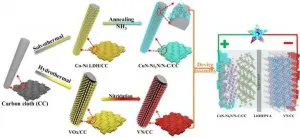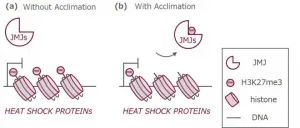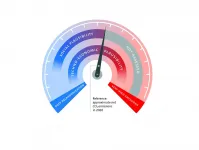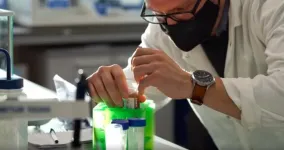(Press-News.org) ITHACA, N.Y. - The Noceto Vasca Votiva is a unique wood structure that was unearthed on a small hill in northern Italy in 2005. Built primarily of oak and slightly larger than a backyard swimming pool, the exact purpose of the in-ground structure has remained a mystery, as has the date of its construction. Italian researchers estimated its origins go back to the late Middle Bronze Age, sometime between 1600 and 1300 B.C.
While that gap might not seem huge, in archeological terms it's like comparing the culture that invented the steam engine with the one that produced the iPad.
A Cornell University team led by Sturt Manning, Distinguished Professor of Arts and Sciences in Classics and director of the Tree-Ring Laboratory, used dendrochronology and a form of radiocarbon dating called "wiggle-matching" to pinpoint, with 95% probability, the years in which the structure's two main components were created: a lower tank in 1444 B.C., and an upper tank in 1432 B.C. Each date has a margin of error of four years.
The finding confirms that the Noceto Vasca Votiva was built at a pivotal moment of societal change, and bolsters the Italian researchers' theory that the structure was used for a supernatural water ritual.
The team's paper, "Dating the Noceto Vasca Votiva, a Unique Wooden Structure of the 15th Century BCE, and the Timing of a Major Societal Change in the Bronze Age of Northern Italy," published June 9 in PLOS ONE.
Manning has led the Tree-Ring Laboratory since 2006, and his team has advanced a range of tools and techniques that have successfully challenged common assumptions about historical artifacts and timelines. Among the lab's specialties is tree-ring sequenced radiocarbon "wiggle-matching," in which ancient wooden objects are dated by matching the patterns of radiocarbon isotopes from their annual growth increments (i.e., tree rings) with patterns from datasets found elsewhere around the world. This enables ultra-precise dating even when a continuous tree-ring sequence for a particular species and geographic area is not yet available.
"Working at an archaeological site, you're often trying to do dendrochronology with relatively few samples, sometimes in less than ideal condition, because they've been falling apart for the last 3,500 years before you get to see them. It's not like a healthy tree that is growing out in the wild right now," Manning said. "We often measure the samples a number of times to extract as much signal as we can."
The Noceto Vasca Votiva is about 12 meters long, 7 meters across and roughly four meters deep - although the depth was a little ambiguous at first. When the site was fully excavated, the researchers found that the structure had a second tank beneath it, which had been built first but collapsed before it was finished. It was initially unclear how much time elapsed between the creation of the two tanks, which shared some of the same materials.
Judging by the size of the structure and the extensive labor that would have been required to excavate the earth and drag timber to the uphill location, the Italian researchers recognized that the Noceto Vasca Votiva was a major undertaking for its era and theorized its purpose. But they were unable to determine the precise date of its origins, and so turned to the Cornell Tree-Ring Laboratory.
Manning's team made multiple attempts with different samples. While the wood from the Noceto site was well-preserved - a rarity, given its age - there was an unexpected challenge when the samples did not seem to fit the international radiocarbon calibration curve that is used for matching tree-ring sequences. This suggested the curve needed revising for certain time periods, and in 2020 a new version was published. The Noceto data finally fit.
By combining radiocarbon dating calibrated via dendrochronologies from southern Germany, Ireland and North America, along with computer-intensive statistics, the Cornell team was able to establish a tree-ring record that spanned several hundred years. They pegged the construction of the lower and upper tanks at 1444 and 1432 B.C., respectively; and they determined the finished structure was in use for several decades before it was abandoned, for reasons that may never be known.
The new timeline is particularly significant because it synchs up with a period of enormous change in Italian prehistory.
"You've had one way of life in operation for hundreds of years, and then you seem to have a switch to fewer, larger settlements, more international trade, more specialization, such as textile manufacture, and a change in burial practices," Manning said. "There is something of a pattern all around the world. Nearly every time there's a major change in social organization, there tends often to be an episode of building what might be described as unnecessary monuments. So when you get the first states forming in Egypt, you get the pyramids. Stonehenge marks a major change in southern England. Noceto is not the scale of Stonehenge, but it has some similarities - an act of major place-making."
Because the structure was located atop a hill and not in the center of a village, it wasn't used as a reservoir or well. The smooth layers of sediment that filled in the structure, and the absence of channels, imply it wasn't used for irrigation. In addition, the researchers discovered a large set of objects deliberately deposited inside the tank, including numerous ceramic vessels, figurines and a range of stone, wood and organic items. All of that evidence indicates the structure was used in some kind of supernatural water ritual.
"It's tempting to think it was about creating a reflective surface that you can see into, and where you put some offerings, but you're also looking at the sky above and the linking of land, sky and water (rain)," Manning said.
Given the fact that nearby settlements in this southern edge of the Po Plain were built with dikes and terraces, and the region was agriculturally productive with much water management, water was clearly important for all aspects of the builders' lives. At least for a time.
"The collapse of the whole social and economic system in the area around 1200 B.C. seems to occur because it becomes much drier," Manning said.
INFORMATION:
Co-authors include senior research associate Carol Griggs and Cynthia Kocik; and researchers from the University of Milano, Italy; and the Complesso Monumentale della Pilotta - Museo Archeologico.
The research was supported by the Italian Ministry of Education, University and Research.
Fast radio bursts, or FRBs, blaze for a few milliseconds before vanishing without a trace. Their origins are unknown, and their appearance is unpredictable. In the decade following their discovery in 2007, only 140 FRBs had been seen. Now, thanks to the launch of a large stationary telescope in the interior of British Columbia in 2018, the number of new FRBs detected has almost quadrupled - for a total of 535. Moreover, the Canadian Hydrogen Intensity Mapping Experiment (CHIME/FRB), a McGill-led inter-university collaboration, has put together the first CHIME/FRB catalogue, which will be presented this week at the American Astronomical Society Meeting.
CHIME is unique in that ...
Recently, a research team led by Prof. ZHAO Bangchuan from the Institute of Solid Materials of the Hefei Institutes of Physical Science (HFIPS) synthesized 3D porous honeycomb-like CoN-Ni3N/N-C nanosheets and vanadium nitride (VN) nanobelt arrays via in-situ growth method, respectively, and constructed a high-energy-density flexible supercapacitor device. The result has been published in Advanced Functional Materials.
Transition metal nitrides (TMNs) are potential electrode materials for high-performance energy storage devices, but the structural instability severely hinders their application. Therefore ...
Ikoma, Japan - "If you can't stand the heat, get out of the kitchen," as the old saying goes. But for organisms that can't leave the proverbial kitchen when things get too hot, there's another way: researchers from Japan have discovered that plants can gain heat tolerance to better adapt to future heat stress, thanks to a particular mechanism for heat stress 'memory'.
In a study published in Nature Communications, researchers from Nara Institute of Science and Technology have revealed that a family of proteins that control small heat shock genes enables plants to 'remember' how to deal with heat stress.
Climate change, especially global warming, is a growing threat to agriculture ...
Prostate cancer is the most common form of cancer among Canadian men and the third leading cause of cancer death. Abdominal obesity appears to be associated with a greater risk of developing aggressive prostate cancer. This link was demonstrated in a END ...
Generally, physics and financial systems are not easily associated in people's minds. Yet, principles and techniques originating from physics can be very effective in describing the processes taking place on financial markets. Modeling financial systems as networks can greatly enhance our understanding of phenomena that are relevant not only to researchers in economics and other disciplines, but also to ordinary citizens, public agencies and governments. And the theory of Complex Networks represents a powerful framework for studying how shocks propagate in financial systems, identifying early-warning signals of forthcoming crises, and reconstructing ...
Today the Hamburg-based Cluster of Excellence "Climate, Climatic Change, and Society" (CLICCS) publishes a new, essential study on climate futures. The study represents the first systematic attempt to investigate whether a climate future with net-zero carbon emissions is not only possible but also plausible. The authors examine plausibility from a technical-economic perspective, but also with regard to the societal changes necessary for such a future. They conclude that deep decarbonization by 2050 is currently not plausible - the current efforts to bring about societal transformation need to be far more ambitious.
The European Union is now increasing the ambition of its climate goals, and the German Federal Constitutional Court has recently committed Germany ...
Researchers have created a plant-based, sustainable, scalable material that could replace single-use plastics in many consumer products.
The researchers, from the University of Cambridge, created a polymer film by mimicking the properties of spider silk, one of the strongest materials in nature. The new material is as strong as many common plastics in use today and could replace plastic in many common household products.
The material was created using a new approach for assembling plant proteins into materials which mimic silk on a molecular level. The energy-efficient method, which uses sustainable ingredients, results in a plastic-like free-standing film, which can be made at industrial ...
Researchers from North Carolina State University have turned a longstanding challenge in DNA data storage into a tool, using it to offer users previews of stored data files - such as thumbnail versions of image files.
DNA data storage is an attractive technology because it has the potential to store a tremendous amount of data in a small package, it can store that data for a long time, and it does so in an energy-efficient way. However, until now, it wasn't possible to preview the data in a file stored as DNA - if you wanted to know what a file was, you had to "open" the entire file.
"The advantage to our technique is that it is more efficient ...
DALLAS, June 10, 2021 -- The distance a stroke patient must travel to receive care at a certified stroke center differs by race, age, income and insurance status, with the largest disparities found among rural residents and American Indians, according to a combined analysis of U.S. census data and road maps published today in Stroke, a journal of the American Stroke Association, a division of the American Heart Association.
Treatment for ischemic stroke, a blockage in an artery that supplies blood to the brain, restores blood flow to the brain. Rapid treatment is essential to reduce disability. Blood flow may be reestablished by administering intravenous clot-busting medication within 4.5 hours after the onset of stroke ...
Polymetallic nodules and crusts cover many thousands of square kilometres of the world's deep-sea floor. They contain valuable metals and rare earth elements and are therefore of great economic interest. To date, there is no market-ready technology for deep-seabed mining. But it is already clear that interventions in the seabed have a massive and lasting impact on the areas affected. This is also confirmed by a study now published by Tanja Stratmann from the Max Planck Institute for Marine Microbiology in Bremen, Germany, and researchers from the Senckenberg am Meer Institute in Wilhelmshaven, Germany, and the Dutch research institute NIOZ.
In their study, Stratmann and her colleagues used data from ...




